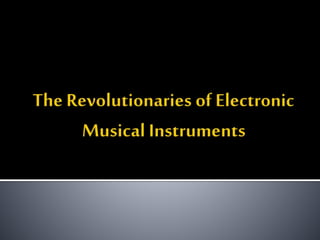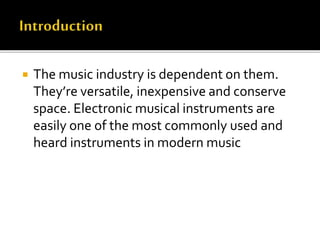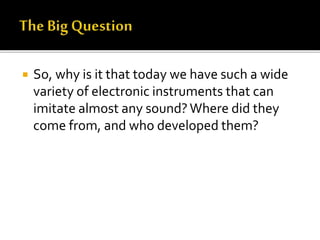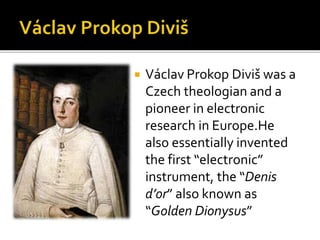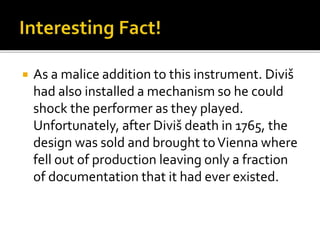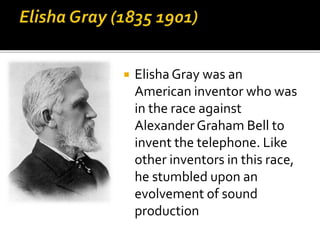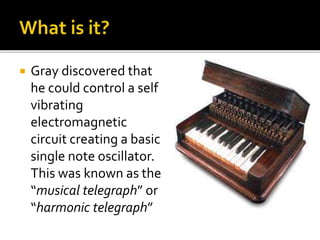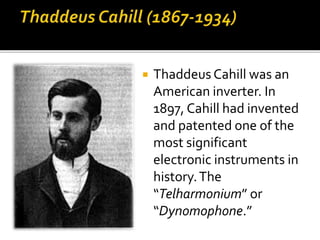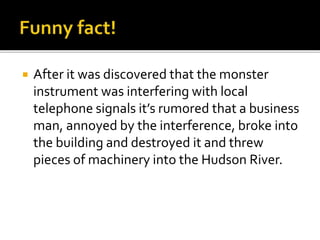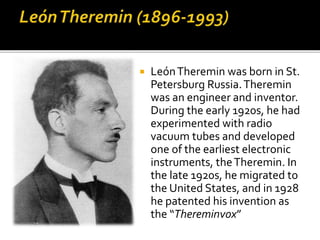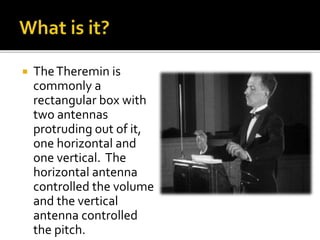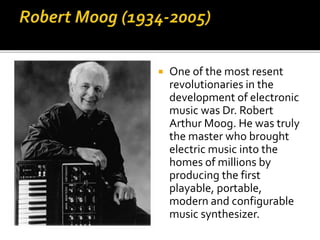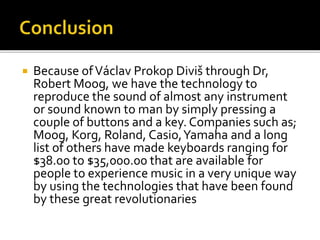The revolutionaries of electronic musical instruments
- 2. ’éĪ The music industry is dependent on them. TheyŌĆÖre versatile, inexpensive and conserve space. Electronic musical instruments are easily one of the most commonly used and heard instruments in modern music
- 3. ’éĪ So, why is it that today we have such a wide variety of electronic instruments that can imitate almost any sound?Where did they come from, and who developed them?
- 5. ’éĪ V├Īclav Prokop Divi┼Ī was a Czech theologian and a pioneer in electronic research in Europe.He also essentially invented the first ŌĆ£electronicŌĆØ instrument, the ŌĆ£Denis dŌĆÖorŌĆØ also known as ŌĆ£Golden DionysusŌĆØ
- 6. ’éĪ It was a; complex, hammer auctioned, piano-style instrument constructed of a wooden cabinet with a keyboard, pedal, and approximately 700 strings. due to the responsiveness and combinations of stops it allowed the player to produce a variety of sounds giving the instrument far more than a hundred tonal voices.
- 7. ’éĪ When it came to the use of electricity this instrument was quite unique, the iron stings were temporarily charged with electricity to ŌĆ£purifyŌĆØ the sound
- 8. ’éĪ As a malice addition to this instrument. Divi┼Ī had also installed a mechanism so he could shock the performer as they played. Unfortunately, after Divi┼Ī death in 1765, the design was sold and brought toVienna where fell out of production leaving only a fraction of documentation that it had ever existed.
- 9. ’éĪ Elisha Gray was an American inventor who was in the race against Alexander Graham Bell to invent the telephone. Like other inventors in this race, he stumbled upon an evolvement of sound production
- 10. ’éĪ Gray discovered that he could control a self vibrating electromagnetic circuit creating a basic single note oscillator. This was known as the ŌĆ£musical telegraphŌĆØ or ŌĆ£harmonic telegraphŌĆØ
- 11. ’éĪ Thaddeus Cahill was an American inverter. In 1897, Cahill had invented and patented one of the most significant electronic instruments in history.The ŌĆ£TelharmoniumŌĆØ or ŌĆ£Dynomophone.ŌĆØ
- 12. ’éĪ It was a collection of approximately 140 altered dynamos accompanied by gear shafts and inductors that produced alternating currents of different audio frequencies.The sound was audible by using piano sound boards.
- 13. ’éĪ TheTelharmonium was a monstrosity. It weighed over 200 tons, sat over 60 feet long and was manned by two musicians.This instrument cost about $200,000 to make and took up an entire floor in the NewYork Telharmonium Hall on 39th Street and Broadway in NewYork Cit
- 14. ’éĪ After it was discovered that the monster instrument was interfering with local telephone signals itŌĆÖs rumored that a business man, annoyed by the interference, broke into the building and destroyed it and threw pieces of machinery into the Hudson River.
- 15. ’éĪ Le├│nTheremin was born in St. Petersburg Russia.Theremin was an engineer and inventor. During the early 1920s, he had experimented with radio vacuum tubes and developed one of the earliest electronic instruments, theTheremin. In the late 1920s, he migrated to the United States, and in 1928 he patented his invention as the ŌĆ£ThereminvoxŌĆØ
- 16. ’éĪ TheTheremin is commonly a rectangular box with two antennas protruding out of it, one horizontal and one vertical. The horizontal antenna controlled the volume and the vertical antenna controlled the pitch.
- 17. ’éĪ One day, Le├│nTheremin vanished and was never to be heard from again until five decades later. It was later learned that he had been kidnapped by the Russian government and imprisoned and was being forced to work for the communist Russian government.
- 18. ’éĪ One of the most resent revolutionaries in the development of electronic music was Dr. Robert Arthur Moog. He was truly the master who brought electric music into the homes of millions by producing the first playable, portable, modern and configurable music synthesizer.
- 19. ’éĪ In 1971 Dr. Moog designed the Minimoog Model D which was the first portable and affordable synthesizer accessible to the general public. Moog set the standard for all manufactures on the production of music synthesizers.
- 20. ’éĪ Because ofV├Īclav Prokop Divi┼Ī through Dr, Robert Moog, we have the technology to reproduce the sound of almost any instrument or sound known to man by simply pressing a couple of buttons and a key. Companies such as; Moog, Korg, Roland, Casio,Yamaha and a long list of others have made keyboards ranging for $38.00 to $35,000.00 that are available for people to experience music in a very unique way by using the technologies that have been found by these great revolutionaries

